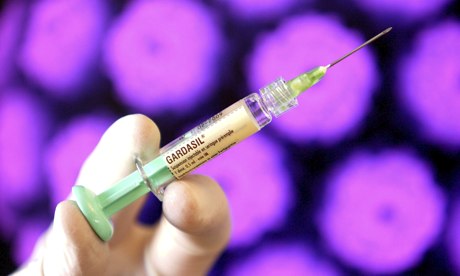
Government advisers are to consider whether the HPV vaccine, routinely offered to girls at the ages of 12 and 13 since 2008 to help protect them against cervical cancer, should also be offered to boys and some men.
They are to review "all the issues" on HPV, including whether targeted vaccination would help cut the risk of anal and throat cancers among men who have sex with men as well as the wider question over whether a universal male vaccination programme given to pre-teen or teenage boys is necessary as well, an idea that has previously been rejected.
The review is revealed in draft minutes of the Joint Committee on Vaccination and Immunisation (JCVI), the UK-wide advisory body.
A decision from the government advisers on what to recommend is unlikely to be quick since JCVI has yet to establish a sub-committee to examine the arguments in detail.
There will be doubts that a UK-wide programme for boys is necessary since take-up of the HPV programme for girls is so good that experts could consider it is enough to protect the general heterosexual population.
The issue of boys getting the vaccine has already been raised in the UK and Scottish parliaments and by the UK charity Throat Cancer Foundation, which believes a UK-wide programme is needed. Supporters believe the present programmes for girls are not offering the same sort of protection for boys as there would be if both sexes were inoculated. The JCVI subcommittee is also to look at whether the programme for girls might soon need to be modified since there is a possibility manufacturers could try to get licences for two-dose courses.
The vaccination, now given in three doses over a year, has already been given to millions of girls – usually in secondary schools – to combat a family of viruses which can also cause warts and verrucas. They are very common and the vaccine, first under the Cervarix brand and now Gardasil, licensed for both boys and girls, is introduced before most girls are sexually active.
Half the population will have some form of HPV at some time in their life and in most cases they suffer no ill effects. The vaccine is known to be effective for eight years. It is unknown how much longer it is effective.
John Ashton, president of the Faculty of Public Health, the professional body, said: "This is to be welcomed. We have to seriously consider this measure in the light of the recent increase in oral cancer. The original decision to vaccinate girls was based on the need to prevent cervical cancer."
The US Centres for Disease Control already recommends boys have it too – and both sexes have it in America when 11 or 12. Australia too offers the vaccine free in schools for both sexes.
The Department of Health said: "There are currently no plans to extend HPV vaccination to males, based on an assessment of currently available scientific evidence." It added: "Vaccination of boys was not recommended by the JCVI because once 80% coverage among girls has been achieved, there is little benefit in vaccinating boys to prevent cervical cancer in girls. 80% coverage for the full course of three doses of the vaccine was achieved in the first year of the HPV vaccination programme in 2008-09, and has since exceeded that level."
It has been estimated that 400 lives a year could be saved in the UK as a result of vaccinating girls before they are infected. At the moment 2,900 women are diagnosed each year with cervical cancer.
Although most girls don't start having sex until after they are 16, the NHS says getting the vaccine as early as possible will protect them in the future.
In 2010, around 4,300 men and 2,200 women were diagnosed with oral cancer, according to Cancer Research UK, a rise of a third in the last decade.

